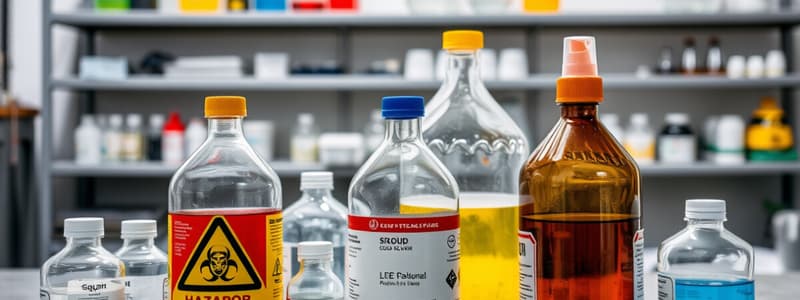Podcast
Questions and Answers
What are the primary symptoms associated with exposure to corrosives like acids and bases?
What are the primary symptoms associated with exposure to corrosives like acids and bases?
- Dehydration and fever
- Headaches and dizziness
- Skin irritation, blistering, and burns (correct)
- Nausea and diarrhea
Which treatment is critical when dealing with cyanide exposure from non-smoke inhalation?
Which treatment is critical when dealing with cyanide exposure from non-smoke inhalation?
- Amyl nitrate, sodium nitrate, and sodium thiosulfate (correct)
- Oxygen therapy only
- Cooling the patient with ice packs
- Administration of activated charcoal
What condition can result from prolonged exposure to solvents?
What condition can result from prolonged exposure to solvents?
- Skin cancer
- Kidney stones
- Pulmonary edema and cardiac dysrhythmias (correct)
- Chronic allergic reactions
In cases of carbon monoxide exposure, what is a recommended treatment?
In cases of carbon monoxide exposure, what is a recommended treatment?
Which of the following must be considered for patient transport after exposure to toxic products of combustion?
Which of the following must be considered for patient transport after exposure to toxic products of combustion?
What is the primary concern when solvents are ingested, leading to vomiting?
What is the primary concern when solvents are ingested, leading to vomiting?
What is a common effect of exposure to chemical asphyxiants like cyanide?
What is a common effect of exposure to chemical asphyxiants like cyanide?
Why is the use of appropriate personal protective equipment (PPE) critical in patient care?
Why is the use of appropriate personal protective equipment (PPE) critical in patient care?
Flashcards are hidden until you start studying
Study Notes
Corrosives
- Acids and bases are corrosives, causing severe burns to skin, eyes, and mucous membranes.
- Symptoms include skin irritation, blistering, burns, and potentially life-threatening airway and lung injuries.
- Treatment involves supportive care: securing airway, oxygenation, pain management, and burn treatment.
- Transport to a burn center may be necessary, and medical control consultation is vital for chemical exposure cases.
Solvents
- Solvents can be liquids, solids, or gases and include paint thinner and nail polish remover.
- They dissolve substances and emit potent vapors, leading to inhalation or skin absorption.
- Prolonged exposure can result in pulmonary symptoms like pulmonary edema, cardiac dysrhythmias, and seizures.
- Vomiting after solvent ingestion can complicate airway management, necessitating careful monitoring.
Pesticides
- Pesticides can produce severe symptoms and require general safety recommendations when handling.
Chemical Asphyxiants
- Chemical asphyxiants, such as cyanide, interfere with oxygen use at the cellular level.
- Cyanide treatment for non-smoke inhalation involves administering amyl nitrate, sodium nitrate, and sodium thiosulfate.
- The antidote for cyanide poisoning from smoke inhalation is hydroxocobalamin (Cyano Kit).
Carbon Monoxide
- Carbon monoxide causes chemical asphyxiation by binding with hemoglobin, rendering oxygen inaccessible to cells.
- Treatment includes removal from the source and administration of 100% supplemental oxygen.
- Consider transport to facilities with hyperbaric chamber capabilities.
Toxic Products of Combustion
- Toxic products are released during material decomposition under heat, including carbon monoxide, carbon dioxide, and nitrogen oxides.
- Proper decontamination protocols must be followed before patient transport; assume field decontamination is insufficient.
Personal Protective Equipment (PPE)
- Ensure appropriate PPE is worn during patient care and transport.
- Minimize patient contact with equipment; use disposable supplies when possible.
- Prepare for transport by double-wrapping the patient and notifying the emergency department in advance.
HazMat Team Monitoring
- Medical monitoring of HazMat team members is essential due to potential heat stress and toxic exposure.
- Factors influencing health include physical fitness, activity level, PPE type, and environmental conditions.
- Pre- and post-assessment of vital signs, EKGs, hydration status, and symptoms is crucial for safety.
- Personnel exhibiting abnormal vital signs should not re-enter hazardous areas until clearance is obtained.
Corrosives
- Acids and bases are highly corrosive, causing severe damage to skin, eyes, and mucous membranes.
- Symptoms include skin irritation, blistering, and severe burns, with the potential for life-threatening airway and lung injuries.
- Treatment necessitates supportive care such as securing the airway, providing oxygen, managing pain, and treating burns.
- Transport to specialized burn centers may be required; consulting medical control is crucial for chemical exposure cases.
Solvents
- Solvents can manifest as liquids, solids, or gases, including common items like paint thinner and nail polish remover.
- They dissolve various substances and release potent vapors, posing risks through inhalation or skin absorption.
- Extended exposure may lead to severe pulmonary issues, cardiac dysrhythmias, and seizures.
- Vomiting after solvent ingestion complicates airway management, necessitating vigilant monitoring of the patient.
Pesticides
- Pesticides can cause severe symptoms and necessitate adherence to general safety procedures during handling.
Chemical Asphyxiants
- Chemicals like cyanide disrupt cellular oxygen usage, leading to asphyxiation.
- Treatment for cyanide exposure from non-smoke inhalation includes amyl nitrate, sodium nitrate, and sodium thiosulfate.
- Hydroxocobalamin (Cyano Kit) serves as the antidote for cyanide poisoning resulting from smoke inhalation.
Carbon Monoxide
- Carbon monoxide causes chemical asphyxiation by binding to hemoglobin, making oxygen unavailable to cells.
- Treatment involves removing the individual from the exposure source and administering 100% supplemental oxygen.
- Transport to facilities equipped with hyperbaric chambers should be considered for severe cases.
Toxic Products of Combustion
- Decomposition materials under heat release toxic substances, including carbon monoxide, carbon dioxide, and nitrogen oxides.
- Proper decontamination protocols are vital before patient transport; field decontamination may not be sufficient.
Personal Protective Equipment (PPE)
- Correct PPE must be utilized during patient care and transport to minimize contamination risk.
- Reduce patient contact with equipment and aim to use disposable supplies when feasible.
- Prepare for transport by double-wrapping the patient and giving the emergency department advance notice.
HazMat Team Monitoring
- Medical monitoring for HazMat team members is critical due to risks from heat stress and toxic exposure.
- Health factors include physical fitness, activity level, type of PPE used, and environmental conditions.
- Conducting pre- and post-assessments of vital signs, EKG results, hydration status, and symptoms is essential.
- Personnel with abnormal vital signs require clearance before re-entering hazardous environments.
Studying That Suits You
Use AI to generate personalized quizzes and flashcards to suit your learning preferences.



